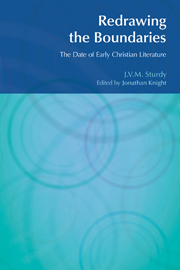Book contents
- Frontmatter
- Contents
- Preface
- Abbreviations
- 1 The Problem Posed
- 2 1 Clement
- 3 The Letters of Ignatius
- 4 Polycarp
- 5 Early Christian Literature: Some Parameters of Date
- 6 The Relationship of the Synoptic Gospels
- 7 Mark
- 8 Luke
- 9 Matthew
- 10 Acts
- 11 The Pauline Corpus: Its Growth and Development
- 12 The Catholic Epistles
- 13 Johannine Literature
- 14 Summary and Conclusions
- Appendix
- Notes
- Bibliography
- Index of Names
- Index of References
6 - The Relationship of the Synoptic Gospels
- Frontmatter
- Contents
- Preface
- Abbreviations
- 1 The Problem Posed
- 2 1 Clement
- 3 The Letters of Ignatius
- 4 Polycarp
- 5 Early Christian Literature: Some Parameters of Date
- 6 The Relationship of the Synoptic Gospels
- 7 Mark
- 8 Luke
- 9 Matthew
- 10 Acts
- 11 The Pauline Corpus: Its Growth and Development
- 12 The Catholic Epistles
- 13 Johannine Literature
- 14 Summary and Conclusions
- Appendix
- Notes
- Bibliography
- Index of Names
- Index of References
Summary
In the rest of this book, we shall examine the date and integrity of the New Testament literature. There is clearly a close relationship between the three Synoptic Gospels Matthew, Mark and Luke. The precise form of this relationship has been a topic of constant discussion and argument; but a clear majority of scholars still subscribes to what has been the consensus theory for almost the whole of the twentieth century. This is that Mark is the oldest Gospel, written between 65 and 75 CE, and that Matthew and Luke are dependent on Mark but independently combine Mark with other material which they drew in all probability from a written source known as “Q.” Both Matthew and Luke are dated to about 80–95 CE. They are independent of one another. Both have also introduced their own special material known as M (Matthew's) and L (Luke's). This may have existed in written form but it is more often thought to consist of material which circulated only orally.
The alternative to this view is the Griesbach Hypothesis, according to which Mark was the third Gospel in the chronological sequence and its author wrote with knowledge of Matthew and Luke. My own research has indicated that this view was first held by Owen and not by Griesbach himself.
Marcan priority was first argued for by J. B. Koppe in 1782 (and not by Lachmann or Holtzmann as is usually suggested). It is now widely agreed that this is a correct solution to one part of the Synoptic Problem.
- Type
- Chapter
- Information
- Redrawing the BoundariesThe Date of Early Christian Literature, pp. 31 - 34Publisher: Acumen PublishingPrint publication year: 2008



